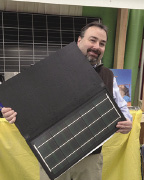"Going green may not cost as much 'green' as most people think - and can even return more 'green' over time," said Russ Cazeault of Cazeault Solar.
Builders and engineers agree that a perfect roof for solar (photovoltaic/PV) shingles or panels would be large, south facing and pitched at an angle between 30º and 45º. Unfortunately, every roof can't be ideally situated.
But Cazeault says, with state-of-the-art solar shingles or panels, an expertly designed system, and experienced installers, "Even a less-than-perfect roof can get great results, saving the residential or commercial customer on their monthly electric bills and adding value to their buildings,"
Cazeault Solar, founded in 1927, is a division of Cazeault Roofing. It's a locally-based third-generation family business that claims to have put more roofs on Cape Cod properties than anyone. Today their service territory covers all of eastern Massachusetts.
Cazeault says that anyone considering a new roof should seriously look at combining that installation with a solar shingle or panel system. Of course, the initial cost will be more, but doing both at the same time is cost-effective.
For example, a traditional roof can cost about $14,700. Doing a new roof with solar panels or including a solar panel system adds about $23,000, bringing the cost to about $37,500. Tax incentives can reduce that total to $28,000. During 25 years, solar panels will save the homeowner over $35,000, and solar renewable energy credits (SREC) will bring another $7,000 in savings. Lifetime savings will total $42,800 and the home's value will increase by $19,000. The expected investment rate of return (IRR) over a traditional roof is estimated to be 11.4%.
Cazeault says the technology, savings, tax credits, rebates, added property value and the overall appearance of today's solar panels make this an ideal time for owners of homes and commercial buildings in Massachusetts to jump into solar. "Costs of solar shingles and panels and faster installation also help lower costs to help buyers reap quicker benefits," he notes. He says, as with any cost-benefit analysis, the estimates are site- specific and should include an analysis of the site's shading, orientation and roof pitch, as well as the solar equipment's efficiency, local electric rates, and other factors.
Upfront costs can be offset by such items as:
* Federal Tax Credit - A 30% federal Investment Tax Credit (ITC) for qualified residential and commercial projects
* MassCEC's Commonwealth Solar II - Rebate for residential and commercial systems that meet program requirements
* Massachusetts Personal Income Tax Credit - The lesser of 15% of the total cost of the PV system or $1,000, for qualified clean energy projects
* Modified Accelerated Cost Recovery System (MACRS) - Accelerated depreciation is available for eligible commercial projects
Among other incentives: Today's solar shingled roofs have a deep, dark, purplish-blue color, closely resembling standard roof shingles so that aesthetics is no longer an issue. Also, the Massachusetts Clean Energy Center provides grants to homeowners and business owners.
For clean energy incentives, Massachusetts residents can visit MassCEC's Financing Clean Energy Projects page http://www.masscec.com/content/financing-clean-energy-projects , or the Database of State Incentives for Renewables and Efficiency (DSIRE) -- http://www.dsireusa.org/
Cazeault Solar is an exclusive distributor in Massachusetts for GAF Solar, and this past year partnered with Dow Chemical as the first contractor in the state to offer Dow's Powerhouseâ„¢ Solar Shingles.
Russ Cazeault sums it up: "Solar has three-fold benefits: It provides green energy, cuts your expenses, and increases the value of and acts as an investment for your home.
Tags:







